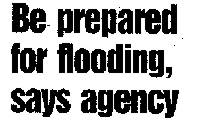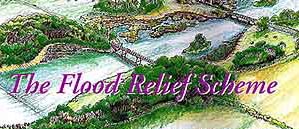Update January 2003
Over the New Year of 2002/03 the River
Thames was in flood and probably reached levels closer to 1947,
the time of last serious floods, than at any other time in the
last 55 years. The Jubilee River took the strain, and the stretch
of the Thames, from Maidenhead to Windsor, that the relief channel
was designed to protect, remained only on Flood Watch with no
property at risk. So the Jubilee River passed its first test
with flying colours, but residents downstream were less impressed!
See Aftermath. See the Floods of 2003 for a report and pictures
from the Windsor area.
The following
was first published in the summer of 2002
Flood Relief Scheme named
The Jubilee River
Will it be up to the job?
In their Newsletter dated April 2001, The
Environment Agency has published the name for the Flood Relief
Scheme between Maidenhead and Windsor. It is to be known as The Jubilee River. This name was chosen following a competition
and was selected from others such as Aquarius, The Garter River,
The Thames Moat, Thamesis, Willow River and Baby Thames
We still maintain that in exceptional conditions, the Jubilee
River will still not prevent flooding of our valley for "once
the valley is full, it is full, and you can dig as many holes
as you like..." there is no doubt that lesser floods will
be prevented with this and the associated flood defences that
are being constructed in tandem with the new channel.
Given very slightly different circumstances, an inundation
could well have happened during the past winter for the past
twelve months have been exceptionally wet. The Agency Newsletter
gives details of monthly rainfall from April 2000 to March 2001
in the catchment area above Teddington Lock, the point at which
the Thames becomes tidal as it flows through the London area.
These figures show that in April 2000 approximately three times
the average rainfall was measured (over 140mm), with May 2000
also being above average too, almost 90mm compared with an average
of under 60mm.
June, July and August allowed some respite being at or
below average levels but then in September figures are up by
around 65% to over 100mm. October 2000 saw almost 160mm of rain
with a particularly violent
rainstorm on the night of October 30th. With further substantial
rain in November and early December, the figures are approaching
double the averages for the period 1961-1990, the standard period
for these averages to be calculated. It was at this time that
the national news was beginning to report serious flood problems
in parts of the country, initially in Kent. A few days later
rivers in Yorkshire were beginning to overtop their banks and
on a variety of occasions numerous areas around the country were
severely affected, including the River Severn which drains water
from the Welsh Mountains through Gloucester to the Severn Estuary.
These inundations were aggravated by Spring tides, the point
each month at which the gravitational effect of both the sun
and the moon are working together to lift natural sea levels
resulting in the highest, and lowest, tide heights of the month.
Yet Windsor was spared.
Our own observations of the river, The
River in November 2000 and The
River in December 2000, show that rainfall and hence periods
of high water levels were concentrated in fairly definable periods,
and although the weather was almost constantly overcast, at least
heavy periods of rain were separated by merely 'damp' periods
that allowed the water to pass through the valley and for river
levels to fall once more before the next period of heavier rain
leading to rising river levels once more
The reason that we suspect that given other circumstances
Windsor could have been in trouble is also reported in the Environment
Agency newsletter. This is the effect of ground water on river
levels and flows. Early in November 2000 experts were reporting
that the likelihood was that unusually extensive flooding would
occur regularly throughout the winter in susceptible areas of
the UK because ground water levels were exceptionally high following
the extended rain of preceding months. The ground can absorb
and, in normal circumstances, retain, large volumes of water,
similar to a giant sponge, only slowly releasing the water as
it filters through into springs and streams. In the last year
we have seen such high levels of persistent rain, that the ground
is saturated and can absorb no more. Any heavy rain thereafter
will flow straight off the surface and into the water courses.
Continued heavy rain will certainly result in rising water levels
as there is a limit to the amount of water that can 'escape'
to the sea. In normal times these limits are rarely exceeded,
and if they are it is for a minimal period, so the effects are
rarely noticed. In 1947 a similar situation existed in that surface
water could not escape fast enough and filled the Thames Valley
to the point at which towns were flooded. But this was because
the preceding winter had been exceptionally cold, substantial
falls of snow had accumulated and when the thaw arrived, it was
a sudden and accompanied by heavy rain upstream. The ground remained
frozen and so the thawing snows and heavy rain, combined and
the flood resulted. The
Floods of 1947. Unfortunately saturated land causes the same
effect.
We are fortunate in this area that a major inundation
did not occur this past winter, but ground water levels remain
the highest for at least forty years. For example, Stonor Manor,
Henley, is four metres (13 feet) above its previous record height
in 1961. Another effect of this increased water table is the
movement of sources of streams. The River Mimram in Hertfordshire
is 5km (3 miles approx.) further up its valley than previously
and there are a number of other examples throughout this area.
Previously dry valleys now have their own streams once more and
over Easter we noticed that farms along the road to Bledlow Ridge
in the Chilterns, all had pumps and hoses laid out, attempting
to pump out water that must have been rising, spring-like, inside
their houses. The road throughout the valley had become a stream
and all farm land throughout this area have puddles, ponds, and
even lakes that just refuse to drain away.
There is little that the authorities can do in such conditions
except hope that this summer will be drier than usual to give
the water courses and land a chance to dry out so that any future
heavy rain in the coming few months can be absorbed. If this
drying out fails to materialise then a repeat of the rainfall
in October and November 2000 will result in higher flood levels
next winter.
Other updates
October 2002. Be prepared!

from The Informer, Windsor, October 9th 2002
Windsor residents are feeling just a tad
bemused by the current headings in the local papers. So what
was the £100 million for? Just how effective will our new
Jubilee River be? Not very it seems from this week's Press Release
from the Environment Agency!
OK, so it is a national campaign to raise awareness
of the chances of flooding in the coming months following the
numerous incidents of flooding around the UK in the last year
or two. Windsor did not suffer then, and probably is less at
risk now with the flood channel completed, but you never know!
October 2001. Scheme nears
completion - "It is ready if it is needed" they say!
In their Newsletter dated October 2001,
The Environment Agency has announced that despite delays caused
by the extensive flooding and high water levels experienced last
winter 2000/2001 work is now almost complete on the structure
to provide additional control over river levels from Maidenhead
through to downstream of Windsor.
Given that last year was an appalling year for many all over
the country, especially Kent, Yorkshire and the Severn Valley,
residents along the Thames Valley can perhaps breathe a sigh
of relief as memories of 1947, now only dim and distant, may
well not be repeated.
It must be said that the Environment Agency are only claiming
to have 'dramatically reduced' the risk of flooding in this area,
although it has been designed to prevent a repeat of the flooding
that happened in 1947.
All that remains to be completed in the coming months is landscaping
and the adding of final touches before next spring.
The project does not only comprise the Jubilee River. Much work
has also been undertaken on raising banks and pathways which
will also help, should high water levels return.
We plan to take additional photographs of the Jubilee River as
time permits. In the meantime we would welcome any that you may
have available, especially if you walk or cycle its length.
Flood
Relief Scheme - Index
River
Thames - Index of Stories
Royal Windsor Home Page

To contact us,
email Thamesweb.
|



